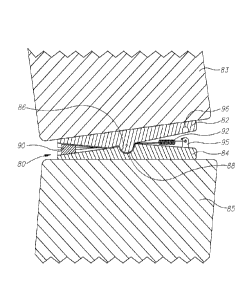Une partie des informations de ce site Web a été fournie par des sources externes. Le gouvernement du Canada n'assume aucune responsabilité concernant la précision, l'actualité ou la fiabilité des informations fournies par les sources externes. Les utilisateurs qui désirent employer cette information devraient consulter directement la source des informations. Le contenu fourni par les sources externes n'est pas assujetti aux exigences sur les langues officielles, la protection des renseignements personnels et l'accessibilité.
L'apparition de différences dans le texte et l'image des Revendications et de l'Abrégé dépend du moment auquel le document est publié. Les textes des Revendications et de l'Abrégé sont affichés :
| (12) Brevet: | (11) CA 2862828 |
|---|---|
| (54) Titre français: | CAGE VERTEBRALE |
| (54) Titre anglais: | SPINAL CAGE |
| Statut: | Octroyé |
| (51) Classification internationale des brevets (CIB): |
|
|---|---|
| (72) Inventeurs : |
|
| (73) Titulaires : |
|
| (71) Demandeurs : |
|
| (74) Agent: | NORTON ROSE FULBRIGHT CANADA LLP/S.E.N.C.R.L., S.R.L. |
| (74) Co-agent: | |
| (45) Délivré: | 2019-03-19 |
| (86) Date de dépôt PCT: | 2013-01-07 |
| (87) Mise à la disponibilité du public: | 2013-07-18 |
| Requête d'examen: | 2017-09-25 |
| Licence disponible: | S.O. |
| (25) Langue des documents déposés: | Anglais |
| Traité de coopération en matière de brevets (PCT): | Oui |
|---|---|
| (86) Numéro de la demande PCT: | PCT/US2013/020454 |
| (87) Numéro de publication internationale PCT: | WO2013/106263 |
| (85) Entrée nationale: | 2014-07-02 |
| (30) Données de priorité de la demande: | ||||||||||||
|---|---|---|---|---|---|---|---|---|---|---|---|---|
|
La présente invention concerne une cage vertébrale (80) comprenant des premier et second éléments de fixation vertébrale (82, 84) qui peuvent être reliés à des vertèbres (83, 85) et qui sont articulés les uns par rapport aux autres par le biais d'une articulation (86, 88), laquelle cage est caractérisée par un élément cale (90) conçu pour assurer le calage entre le premier et le second élément de fixation vertébrale (82, 84), ainsi qu'un actionneur (92) qui est relié à l'élément cale (90) et est conçu pour déplacer ce dernier dans une direction qui permet de caler plus loin l'élément cale (90) entre le premier et le second élément de fixation vertébrale (82, 84), ou de l'éloigner du premier et du second élément de fixation vertébrale (82, 84).
A spinal cage (80) including first and second spinal attachment members (82, 84) attachable to vertebrae (83, 85), the first and second spinal attachment members (82, 84) articulating with one another by means of an articulation joint (86, 88), characterised by a wedge element (90) arranged for wedging between the first and second spinal attachment members (82, 84), and an actuator (92) linked to the wedge element (90) for moving the wedge element (90) in a direction that wedges the wedge element (90) further in between the first and second spinal attachment members (82, 84) or further away from the first and second spinal attachment members (82, 84).
Note : Les revendications sont présentées dans la langue officielle dans laquelle elles ont été soumises.
Note : Les descriptions sont présentées dans la langue officielle dans laquelle elles ont été soumises.

Pour une meilleure compréhension de l'état de la demande ou brevet qui figure sur cette page, la rubrique Mise en garde , et les descriptions de Brevet , États administratifs , Taxes périodiques et Historique des paiements devraient être consultées.
| Titre | Date |
|---|---|
| Date de délivrance prévu | 2019-03-19 |
| (86) Date de dépôt PCT | 2013-01-07 |
| (87) Date de publication PCT | 2013-07-18 |
| (85) Entrée nationale | 2014-07-02 |
| Requête d'examen | 2017-09-25 |
| (45) Délivré | 2019-03-19 |
Il n'y a pas d'historique d'abandonnement
Dernier paiement au montant de 263,14 $ a été reçu le 2023-12-18
Montants des taxes pour le maintien en état à venir
| Description | Date | Montant |
|---|---|---|
| Prochain paiement si taxe applicable aux petites entités | 2025-01-07 | 125,00 $ |
| Prochain paiement si taxe générale | 2025-01-07 | 347,00 $ |
Avis : Si le paiement en totalité n'a pas été reçu au plus tard à la date indiquée, une taxe supplémentaire peut être imposée, soit une des taxes suivantes :
Les taxes sur les brevets sont ajustées au 1er janvier de chaque année. Les montants ci-dessus sont les montants actuels s'ils sont reçus au plus tard le 31 décembre de l'année en cours.
Veuillez vous référer à la page web des
taxes sur les brevets
de l'OPIC pour voir tous les montants actuels des taxes.
Les titulaires actuels et antérieures au dossier sont affichés en ordre alphabétique.
| Titulaires actuels au dossier |
|---|
| APIFIX LTD. |
| Titulaires antérieures au dossier |
|---|
| S.O. |